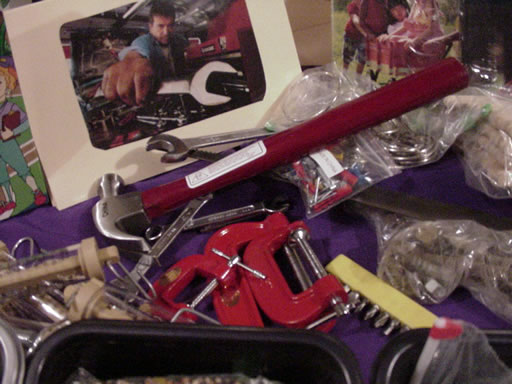 |
Grade
Level: Elementary, K-2
|
Description:
|
| Description:
This kit helps students learn about the concepts of work and
force. They develop an understanding of how machines extend
people's ability to get work done. Simple and complex machines
are identified. Children have opportunities to measure the amount
of force needed using spring scales. Literacy connections are
also made within the kit. |
| Designer:
Marty Belanger (Caribou Elementary School) |
| History:
Designed in 1998 using MMSA grant, copied in 2000 for the Library
of Traveling Trunks |
| |
Educational
Content
|
| The Simple Machines trunk was
designed using the following guidelines established by the Maine
State Learning Results. |
Science Pre K - 2
|
| |
E. STRUCTURE OF MATTER
|
| |
E1 - Show that large things are made of smaller pieces
E2 - Describe some physical properties of objects.
E3 - Group objects based on observable characteristics (e.g.,
color, size, texture)
|
| |
I. MOTION
|
| |
I1 - Develop a variety of ways to describe the motion of an
object
I2 - Demonstrate that the motion of an object can be changed
|
| |
K. SCIENTIFIC REASONING
|
| |
K2 - Distinguish between important and unimportant information
in simple arguments
K3 - Make observations
K4 - Participate in brainstorming activities
K5 - Use various forms of simple logic
|
| |
L. COMMUNICATION
|
| |
L1 - Describe and compare things in terms of number, shape,
texture, size, weight, color, and behavior
L3 - Ask clarifying questions
L4 - Explain problem-solving processes using verbal, pictorial,
and written methods
L5 - Make and read simple graphs
L6 - Use objects and pictures to represent scientific and technological
ideas
|
| |
M. IMPLICATIONS OF SCIENCE AND TECHNOLOGY
|
| |
M2 - Describe at least two inventions, what they do, how they
work, and how they have made life easier
M5- Explain how their lives would be different without specific
inventions or scientific knowledge
|
Mathematics Pre K - 2
|
| |
A. NUMBERS AND NUMBER SENSE
|
| |
A2 - Understand the many uses of numbers.
A4 - Determine reasonableness of results when working with quantities
|
| |
C. DATA ANALYSIS AND STATISTICS
|
| |
C1 - Formulate and solve problems by collecting, arranging,
and interpreting data.
C2 - Make tallies and graphs of information gathered from immediate
surroundings.
|
| |
F. MEASUREMENT
|
| |
F3 - Select standard and non-standard tools for determining
length, time, temperature, weight, and capacity, and use them
to solve every day problems.
|
| |
J. MATHEMATICAL REASONING
|
| |
J2 - Distinguish between "important" and "unimportant"
mathematical information
|
Contents
|
|
Notebook: MSLR support, lesson plans, assessment,
etc.
Videos: "Magic School Bus Plays Ball"
Books & Publications:
- "What Makes Things Move"; Althea; Troll Associates,
1991; ISBN 0-8167-2124-6
- "Katy and the Big Snow"; Virginia Lee Burton;
Houghton Mifflin, 1971; ISBN 0-395-18155-0
- "Push and Pull"; Marcia Freeman; Newbridge
Educational Publishing. 1997; ISBN 1-56784-318-2 (Qty: 1-large,
6-small, teacher's guide)
- "Simple Machines"; Melvin Berger; Newbridge
Educational Publishing 1995; ISBN 1-56784-103-1(Qty: 1-large,
6-small, teacher's guide)
Posters: 6 small - (lever, inclined plane, wheel
and axle, screw, wedge, pulley)
Objects:
1 eraser
1 wooden 4x4x3/4 routed tile
9 plastic tins
Colored faceted beads
Colored/shaped opaque beads
Notebook rings
Cotton balls
Small colored craft balls
Long-grain rice
Bird seed
Small rocks
Assorted screws and bolts
Popsicle sticks
Kidney beans
Lima beans
Elbow macaroni
Black-eyed peas
Roofing nails
Wooden spools
Gray slate mini tiles
Colored plastic lock cubes
Tool Kit:
3 C clamps
1 hammer
1 drywall knife
1 hole saw
2 wrenches (3/8, 7/16, 5/8)
1 adjustable wrench
1 needle-nose pliers
1 socket driver
10 socket heads
scissors
Exacto knife
6 screwdrivers (common & philips)
baggie of tacks, screws, inserts, picture hangers
8 hanging scales
|
 |